 |
Crunch Leslie Connor The ability to get into a car and drive anywhere is often taken for granted, but in this novel, readers are taken not too far into the future to a time where there are severe gas restrictions and occasionally no available gas at all. Dewey Mariss and his siblings find themselves in this situation when they learn that their parents are stranded at the Canadian border trying to make their way home during a summer where people have turned to bicycles as a real means for getting around. Dewey takes responsibility for his father’s side business–a bicycle repair shop–and knows the thrill of pride when he and his brother Vince are able to handle things even though their dad is away. When parts begin to disappear from the shop and people bring more bikes to “The Bike Barn” than the two brothers can possible handle, however, Dewey and his older sister, Lil, clash over what is in the best interests for the five Mariss children while their parents are away. Nevertheless, Dewey is resolved to do what is best for the family and the Bike Barn, including solving the mystery of who is taking the parts and stealing bikes. The characters in this story are well developed and their reactions to the various challenges they face ring true. This book should be a favorite with younger readers. 2010, Katherine Tegen Books/HarperCollins, Ages 10 to 14, $16.99. REVIEWER: Jean Boreen, Ph.D. (Children’s Literature). ISBN: 9780061692291 |
 |
E-I-E-I-O Judy Sierra Illustrated by Matthew Myers In this variation of the old song, Old MacDonald has a house, and a yard that he does not enjoy mowing. The sprightly rhymes are regularly punctuated with the E-I-E-I-O chorus. He tries a goat but finds it to be no help, so he gets a very bright chicken. Following her clever instructions, he gradually lays down dirt, puts down garbage, and gets a horse for “poop.” Then he sets up a compost box to deal with the smell. Next, he orders seeds to plant, “and magic happened underground.” Soon Mac is selling cheese, eggs, honey, and fresh-grown food. Old MacDonald now loves his farm, with a final E-I-E-I-O! Cartoon characters produced in acrylic and oils act out this revised version of the old ditty, as they show the evolution of a productive farm, first producing and selling from a garden cart and then expanding to the multi-crop farm, complete with red barn, chicken coop, beehive, and yellow sunflowers. 2014, Candlewick Press, Ages 4 to 8, $16.99. REVIEWER: Ken Marantz and Sylvia Marantz (Children’s Literature). ISBN: 9780763660437 |
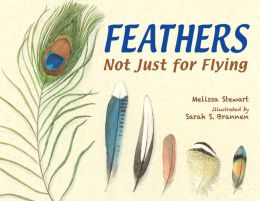 |
Feathers: Not Just For Flying Melissa Stewart Illustrated by Sarah Brannen Feathers are not only a means of avian locomotion-they also have many secondary purposes for birds. “Feathers can warm like a blanket… or cushion like a pillow,” writes Stewart. “Feathers can shade out sun like an umbrella… or protect skin like sunscreen.” Making skillful use of trompe l’oiel, Brannen’s delicate, refined watercolors give the project the feel of a birders’ scrapbook, as though the feathers, “photographs,” informational notes, and other ephemera that appear have been taped, stapled, and clipped to the pages (one note even has a telling coffee cup stain). A focused and thorough examination that highlights the striking beauty of these often-unnoticed natural objects. 2014, Charlesbridge, Ages 6-9, $17.95. REVIEWER: ★ Publishers Weekly (Publishers Weekly). ISBN: 9781580894302 |
 |
Green Technology Mike Hobbs Recycling pop cans, paper, and other household items are just a few ways that people can help protect the environment from pollutants and waste that accumulate daily. For example, Kyle Berner came up with the brilliant idea of making flip-flops from natural materials like rubber trees and bamboo, and three guys from Utah developed a method for turning all the restaurant food waste into organic compost. Inside this middle reader of “The Young Entrepreneurs’ Club” series, children will learn about some amazing and creative methods for protecting their world. This book begins by explaining what green technology is and describing an ecopreneur. Each page takes the reader step-by-step through the process of inventing ways for improving the environment, beginning with brainstorming and moving to product development and marketing. Young entrepreneur spotlights are scattered throughout the pages, sharing the successful ideas of teen and young adults who have worked to make the world a greener place. Questions and challenge activities encourage discussion and reflection, making this book an excellent educational tool for elementary and middle school teachers. Overall, this book will inspire children and teens to use their brilliant minds to make the world a better place. 2014, Smart Apple Media/Black Rabbit Books, Ages 9 to 14, $35.65. REVIEWER: Justina Engebretson (Children’s Literature). ISBN: 978159920258 |
 |
Jo MacDonald Hiked in the Woods Mary Quattlebaum Kids love a great story with familiar songs so that they can look at pictures and sing along. Jo MacDonald and her grandfather are out for a stroll in the woods. They admire the tall trees as they walk and sing. The forest has animals like woodpeckers who make a rat-tat sound as they peck the trees. They see wild turkeys that gobble and chipmunks that chomp on nuts. Snakes slither and turtles shuffle. Jo and her grandfather put those sounds together and sing a tune that sounds like an original song, Old MacDonald. For example, one verse reads: “And in those woods she heard a skunk E-I-E-I-O. With a pad-pad here and a pad-pad there, Everywhere a pad-pad. Jo MacDonald hiked in the woods, E-I-E-I-O.” Young readers will learn all about the animals that live in the woods. Sing-song words and rhythm make for a fun read. Colorful illustrations are a delight as children pick their favorite critters. The back of the book has a picture of the animals and plants found on the pages along with descriptions of them. There is also an activities section so kids can hone their skills as naturalists. Parents and teachers will enjoy sharing this story and adding it to their libraries. 2013, Dawn Publications, Ages 3 to 7, $8.95. REVIEWER: Kristi Bernard ISBN: 9781584693352 |
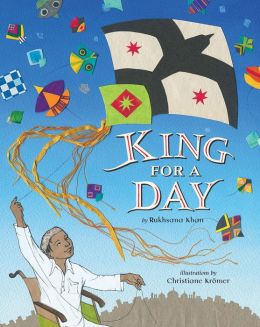 |
King For a Day Rukhsana Khan Illustrations by Christiane Kreomer Children’s Literature – Ken Marantz and Sylvia Marantz During the spring festival of Basant in Lahore, Pakistan, our narrator young Malik looks forward to launching his kite Falcon in the traditional kite-flying battles. He particularly wants to settle accounts with the bully next door. His sister helps him launch his small but speedy Falcon. Malik manages to snap the strings of both of the bully’s kites. Then he flies Falcon to conquer many others. The downed kites then belong to whoever catches them when they fall. His brother and sister collect many. Malik truly feels like King of the Kites. Then, with one kind gesture, he brings his successful day to a happy end. Kromer uses mixed media and collage to create a striking and successful visual story, with the kites providing the major visual impact. A double-page scene of the flight from the rooftop with close to a hundred brilliant kites being guided to cut others free is most powerful. The naturalistic illustrations also inform us about the streets, houses, and clothing. The final double-page night scene from the rooftop showing the sky full of stars and exploding rockets makes a satisfying ending. 2013, Lee & Low, Ages 4 to 7, $17.95. REVIEWER: Ken Marantz and Sylvia Marantz (Children’s Literature). ISBN: 9781600606595 |
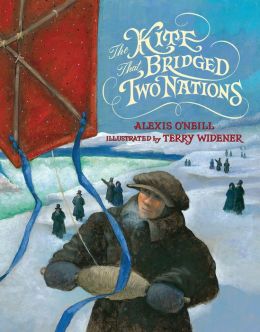 |
The Kite That Bridged Two Nations: Homan Walsh and the First Niagara Suspension Bridge Alexis O’Neill Illustrated by Terry Widener In 1847 engineer Charles Ellet, Jr. set out the challenge for an enterprising kite flier to lay out the first line across the Niagara River at the site at which he was commissioned to build a bridge. Irish immigrant teenager Homan Walsh managed to send his octagonal calico kite from the Canadian to the American shore in the dead of winter, thereby winning a ten-dollar prize and bragging rights to completing the first step in the construction of the international bridge. O’Neill recreates Walsh’s feat based on clues from period documents and memories from Walsh himself late in his life. The story is a fairly loose treatment, with imagination filling in historical gaps, but the author meticulously distinguishes fact from speculation in her lengthy closing note. Walsh narrates his first failed and second successful attempts with a rhythmic cadence that will be a pleasure for reading aloud: “Then suddenly, a sag, a jerk./ The heavy line went slack!/ It snapped on ice below./ No kite./ No cord./ No union.” Widener’s acrylic scenes make the most of the contrast of weather and terrain, contrasting the golden warmth of Walsh’s nights indoors making his kite with the chilly steel blues and grays of the ice-clogged river and snow-frosted banks. Source notes are included. Review Code: R — Recommended. 2013, Calkins Creek, Ages 5-8 yrs, $16.95. REVIEWERS: Elizabeth Bush (The Bulletin of the Center for Children’s Books). ISBN: 9781590789384 |
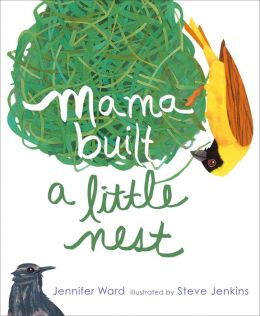 |
Mama Built a Little Nest Jennifer Ward Illustrated by Steve Jenkins Jenkins’s (Animals Upside Down) signature paper collages handsomely illustrate this inviting read about bird nest variety. Ward (What Will Hatch?) showcases 14 nest types, from simple scrape nests to intricately woven ones, with rhythmic verses that begin the same way: “Mama built a little nest,” although there’s some variation on that theme (“Daddy built a little nest”). Realistic vignettes of birds and their nests are set against a white backdrop; spots of vibrant color accent the muted hues of the mostly female nest builders. In one scene, deep ruddy shades adorn a female grebe’s majestic profile as she swims near her nest: “Mama built a little nest./ She gathered twigs that float/ and placed them on the water/ to create a cozy boat.” Captions alongside the illustrations offer additional information about nesting materials and habits. Families using this as a bedtime book will appreciate the snug ending: “You have a nest- “your very own!/ A place to rest your head/ with pillows soft and cozy thoughts-/ your nest is called a bed!” 2014, Beach Lane/Simon & Schuster, Ages 4-8, $17.99. REVIEWER: *Publishers Weekly (Publishers Weekly). ISBN: 9781442421165 |
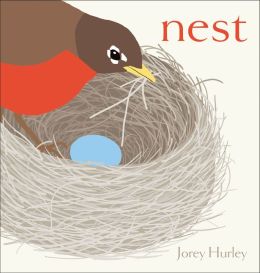 |
Nest Jorey Hurley A single word on each spread is all the text needed as the double-page illustrations tell the story, beginning and ending with “nest.” Two robins sit above a blue egg in the nest. It is kept “warm” in the rain. The baby robin hatches, grows, flies, feasts, and snuggles as the snow falls, before finally meeting another robin to build a new “nest” together. A life-size sequence of robins plus naturalistic branches, leaves, and nest are rendered in Photoshop. The cover displays a solidly built nest on the back plus nest, bird, and egg on the front. Blue eggs fill the end pages. A note adds extensive information about robins and their habits. 2014, Simon & Schuster Books for Young Readers, Ages 3 to 7, $16.99. REVIEWER: Ken Marantz and Sylvia Marantz (Children’s Literature). ISBN: 9781442489714 |
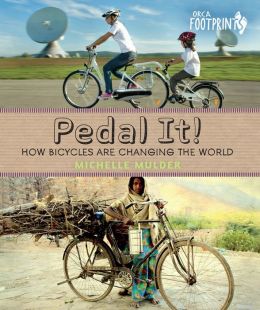 |
Pedal It!: How Bicycles Are Changing the World Michelle Mulder Authors are most successful when they write about a topic with which they are familiar. Michelle Mulder is a bike enthusiast who has written a hugely entertaining and informative nonfiction book about bicycles. After buying her first bike when she was 15 and riding it for 20 years, Mulder is a guru when it comes to bicycles. Her personal experiences found in sections labeled ‘On My Route’ and photos add to the easy flow of her narrative. She begins with the history of the bicycle – including descriptions and archival photos of the walking machine, the boneshaker and the high wheeler. Next invented were bikes with air in the tires to save poor bodies from all the bumps in the road. There are drawings of bike parts and gears and even instructions on how to ride by making the bike become an extension of your body. Flight engineers, like the Wright brothers and Paul B. MacCready, are cited for their use of the bicycle in their early attempts at flight. Mulder is clearly a bike promoter. Not only do she and her family ride everywhere, having no family car, but she writes about all the ways in which cycling can help to save the earth. While cars are draining the world’s supplies of oil and natural gas, using the bicycle for transportation seems like the obvious solution. Not only used for transporting people, bicycles are used in many countries to transport goods, power other machines like knife sharpeners and to charge batteries. In hard to reach parts of the world, bicycles are even used as ambulances, transporting sick people to hospitals. The format of Pedal It! is easy to follow, and interesting facts are on every page. “Quick Bike Fact[s]” are scattered on various pages as well as tracks and drawings of old fashioned bikes and gears. Colour and black and white photos are displayed. Interestingly, many photos were sent to Mulder from all over the world to be included in this book. The websites included at the back of the book offer a chance to contact Bicycles for Humanity and the Bamboo Bike Project, to name only two exciting bicycle projects. Hang onto your handlebars! Pedal It! is a must-read for kids and adults alike. Now go dust off your bike! Highly Recommended. Rating: **** /4. Grades 3-8. (Orca Footprints) 2013, Orca, 48 pp., hardcover, pdf, epub, $19.95 (hc). Ages 8 to 13. REVIEWER: Sherry Faller (CM Magazine). ISBN: 9781459802193 |
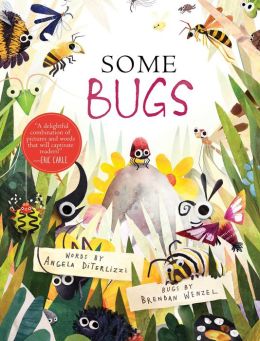 |
Some Bugs Angela DiTerlizzi Illustrated by Brendan Wenzel “The illustrations for this book are rendered in almost everything imaginable,” reads the note on the copyright page of this marvelous encyclopedic look at backyard entomology. What specificity is lacking in this materials citations, debut artist Wenzel more than makes up for in terms of conveying his artistic delight at depicting more than 45 bugs-from the glamorous Monarch butterfly to the leaping Lubber grasshopper, from the tiny pink aphid to the give-it-a-wide-berth scorpion. Even the most squeamish or squash-happy reader will find these critters easy to love. They live in relative harmony (although the endearingly odd Hercules beetles are spoiling for a fight) and busily go about their buggy tasks in the grass, on the wing, and around the pond with bright, eager bug eyes. “Some bugs build./ Some bugs make./ Some bugs hunt./ And some bugs take!” reads DiTerlizzi’s (Say What?) jaunty verse as an ambitious armada of ants raids a picnic basket. So vivid are Wenzel’s compositions that readers will feel transported to a summer day, when the air is musical and life is literally buzzing. 2014, Beach Lane/Simon & Schuster, Ages 4-8, $17.99. REVIEWER: ★ Publishers Weekly (Publishers Weekly). ISBN: 9781442458802 |
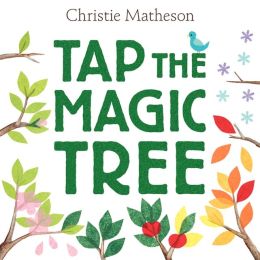 |
Tap the Magic Tree Christie Matheson This is a deceptively simple book in terms of its illustrations and texts, but it conveys a creative and charming message perfect for its young readers. The base illustration throughout the book is of a tree in winter, before it has begun to leaf for the season. Short text directions like “Tap it once. Turn the page to see,” tell younger readers exactly what to do page by page; as each page is turned, the reader gets a surprise. The surprises match the passing of seasons, and the author/illustrator uses simple illustrations within a collage format to show this progression. I especially loved the actions the young reader has to take as she is either reading the book herself or reading it with another that are sure to delight the youngster: finger wiggling, knocking on the trunk of the tree, and blowing a breeze to create a change that will show up on the next page are just a few of the fun activities children as asked to do as they are reading this book. I completely enjoyed interacting with this book, which is sure to be a hit. 2013, Greenwillow/HarperCollins, Ages 4 to 8, $15.99. REVIEWER: Jean Boreen (Children’s Literature). ISBN: 9780062274458 |
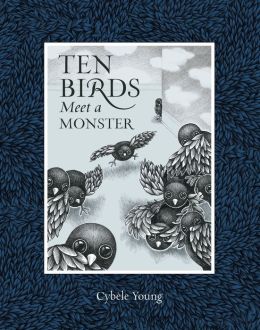 |
Ten Birds Meet a Monster Cybèle Young The ten birds that first appeared in the award-winning Ten Birds return to encounter a scary menace. Without words, the birds’ fear of this monster is evident; what can they do? The first bird devises a polka-dot rival but this does not remove the beast. A second bird joins the first and hopes to create a rival monster by using the clothes scattered about the floor. Alas, still no success eliminating the monster. As birds join the group one by one, they create a progressively larger and more menacing creature. The monster remains. Finally, the tenth bird moves towards the monster and finds a clever way to eliminate this scary menace. Young uses various textures in her pen-and-ink drawings to distinguish the birds from the materials of their “creatures.” On the page that faces the latest creature that the birds create, readers can see how many birds remain; the smaller illustration shows the birds left behind. As a result, while the story is a clever counting book, it is a subtle book about subtraction as well, making it a success for older audiences as well. Whether a reader in kindergarten to second grade wants to help the birds succeed in their mission to vanquish the monster or to count along, this picture book succeeds admirably. 2013, Kids Can Press Ltd, Ages 4 to 7, $16.95. REVIEWER: Elizabeth Fronk (Children’s Literature). ISBN: 9781554539550 |
 |
Theme Parks, Playgrounds, and Toys Nicolas Brasch Part of “The Science Behind” series, Brasch addresses the physics of exciting everyday objects, including roller coasters, bumper cars, and slides. With roller coasters, Brasch explains potential and kinetic energy and relates it back to Newton’s laws of motions. With bumper cars, Brasch explains the first and third law of motion. And with slides, he looks at the effects of friction and gravity and how both of these forces interact with an inclined plane. The purpose of this series is to look at questions that children often have, and to that end, the topics are listed as questions at the beginning of each spread. Each of the three topics above, plus ten others, is supported by graphics with arrows showing motion and multiple captions. The double-spread sections also has its own vocabulary words in a yellow box, as well as a box marked “Web Watch” with links for more information, and other boxes with one or two interesting facts; for roller-coasters the facts box describes the “World’s Tallest and Fastest Roller-coaster.” The writing is clear and straightforward and the layout is clear, if not inspired, however, with topics as exciting as roller coasters, Brasch didn’t need flashy work to attract readers. Back-matter includes two hands-on projects and an index. The glossary is in the text. 2010, Black Rabbit Books, $28.50. Ages 10 up. REVIEWER: Amy S. Hansen (Children’s Literature). ISBN: 9781599205625 |
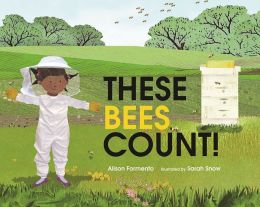 |
These Bees Count Alison Formento Illustrated by Sarah Snow From the author of This Tree Counts!, These Seas Count!, and These Rocks Count! comes another interesting adventure with Mr. Tate’s class. The class takes a bus to Busy Bee Farm where they meet Farmer Ellen. She explains how bees produce honey, and everyone dresses into beekeeper gear before they look at the apiaries on the farm. In the middle of the story, when the bees take off to visit the flowers, Formento weaves counting from one to ten items into the text, as the bees fly to do their work, collecting pollen. The illustrations comprise cut outs that attractively support the text. The end pages greet the reader with golden honeycombs and some bees. The greenery of the plants on the farm, the colors of the flowers, and the amber shades of honey in jars are just a few examples of the beautiful illustrations. At the end of the story, readers will find additional information about honeybees. Children who enjoy nature will probably enjoy this book. 2012, Albert Whitman & Company, Ages 4 to 7, $16.99. REVIEWER: Carrie Hane Hung (Children’s Literature). ISBN: 9780807578681 |
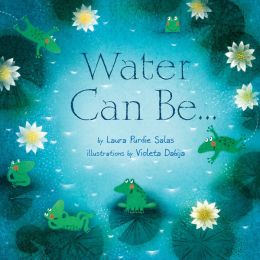 |
Water Can Be . . . Laura Purdie Salas Illustrated by Violeta Dabija It is a definite challenge to find nonfiction, Core Curriculum books that can be integrated into early grade lesson plans. Author Laura Salas skillfully helps to fill this need with her book on the poetic and practical used of water. In just one or two words per page, she describes water as an environment for animals, calling it a “home maker” for aquatic animals. She also points to it as an element in the water cycle (“garden soaker” for flowers and vegetables) and a vital element for humans and animals (“school drink-er” and “otter feeder”). The book explains, primarily through pictures, the various forms of water (fluid, ice, and clouds). The illustrations are deeply color-drenched watercolors, but a bit hazy as if the viewer is looking at them through a steamed up window. The cover, with red-cheeked frogs lazily lounging on lily pads, will immediately attract readers through color and humor. The pictures invite extension through discussion, as students readily identify animals that live amid ocean bottom coral reefs and stretch their knowledge about other biomes, such as lakes, rivers, and swamps, where water figures prominently in the eco-system. The backmatter defines each pages caption and explains, in simple terminology, how water interacts with plants, animals and humans. It might have been better if these definitions had been placed in sidebars to answer students’ questions more immediately, but this arrangement may help create avenues for imaginative answers. In keeping with current school demands, suggestions for additional readings are provided, and all have relatively current copyrights. No Internet resources are listed, and this seems to be standard in the current crop of nonfiction books. 2014, Millbrook/Lerner, Ages 5 to 8, $17.95. REVIEWER: Lois Rubin Gross (Children’s Literature). ISBN: 9781467705912 |
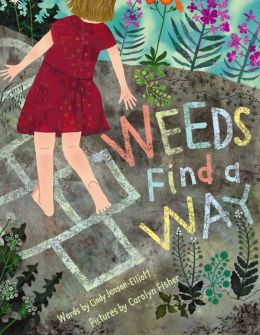 |
Weeds Find a Way Cindy Jenson-Elliott Pictures by Caroly Fisher “Good or bad, weeds offer endless opportunities to study one of nature’s most wonderful tools: adaptation,” writes Jenson-Elliott in an afterword to this flowery (no pun intended) tribute to the tenacity and versatility of plants that are often overlooked and unwanted. Using mixed-media paintings and digitally collaged elements, Fisher (Good Night, World) presents up-close images of feathery seeds bursting from pods, “like confetti from a popped balloon,” and squeezing their way out of cracks in the cement. A girl and her dog make their way through several scenes, adding a touch of fauna amid the flora. In one scene, the girl blows dandelion puffs into the wind; in another, a handful of “prickly burrs” cling to her socks, both evidence of how weeds can propagate. In addition to her afterword, Jenson-Elliott concludes with three pages of details about two dozen types of weeds, from wild carrot (aka Queen Anne’s lace) to toxic locoweed. The many intriguing details will leave readers with the understanding that these plants are fighters. 2014, Beach Lane/Simon & Schuster, Ages 4-8, $16.99. REVIEWER: Publishers Weekly (Publishers Weekly). ISBN: 9781442412606 |
 |
What’s Sprouting in My Trash? : A Book About Composting Esther Porter STARRED REVIEW! Three Cheers for Trees and What’s Sprouting in My Trash, two books from the Earth Matters series, offer simple, clear and accurate explorations of their subjects. Aimed at early primary school children, each book has easy to read text with related color illustrations. Short glossaries and supplemental reading lists at the ends of the books are a plus. An online reference, www.facthound.com, leads to additional material. What’s Sprouting in My Trash introduces nature’s own recycling, of fallen leaves helping to enrich the soil. Worms and microorganisms in the soil do the work to turn waste into humus. The book describes composting, including what should and should not be used yes to vegetable material, no to meat since it may attract unwanted wild animal attention. It suggests experimenting with composting in a glass jar. I did not try this but it seems an interesting idea. The rest of the material on composting is consistent with my long experience in having compost piles that turn into humus very useful for gardening. . . .The other book, Three Cheers for Trees, discusses our carbon footprint, including why we call it that, and has suggestions for reducing it, celebrating the importance of trees in the carbon cycle. Mentioned are reuse of material goods and recycling of items not reusable and substituting walking or bicycling for mechanized transit. 2013, Capstone, Ages 6 to 9, $19.99. REVIEWER: *Paul R. Cooley (Science Books & Films). ISBN: 9781620650479 |
Science of Spring
 |
Plants, birds, bugs, wind, motion, bikes-all point to spring. It’s a season filled with opportunities for science learning through science in action. The titles below provide a great jumping off point. On your mark…get set…go! Web links to additional information and activities about springtime science follow these reviews. Contributor: Peg Glisson |
Reviews
|



